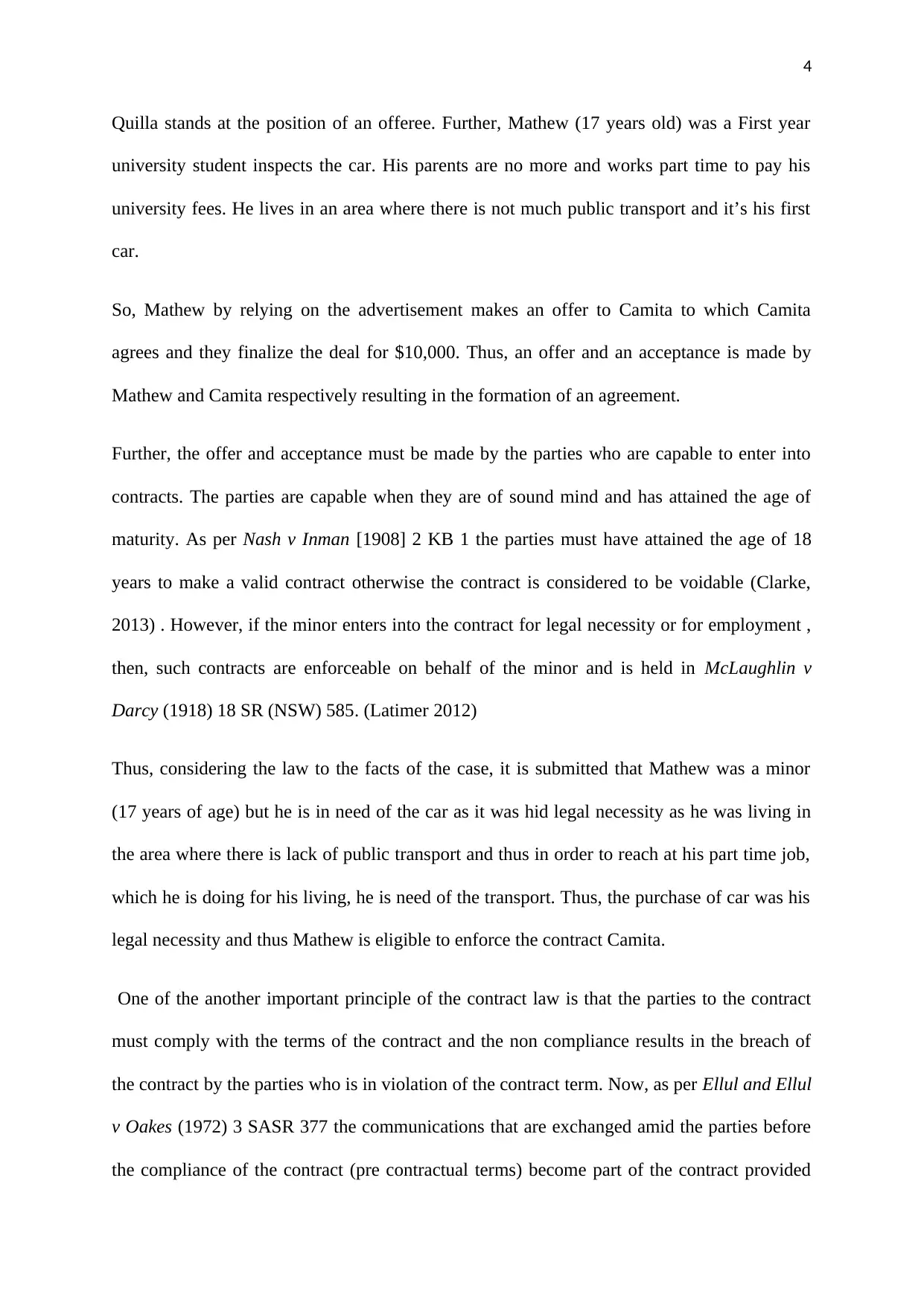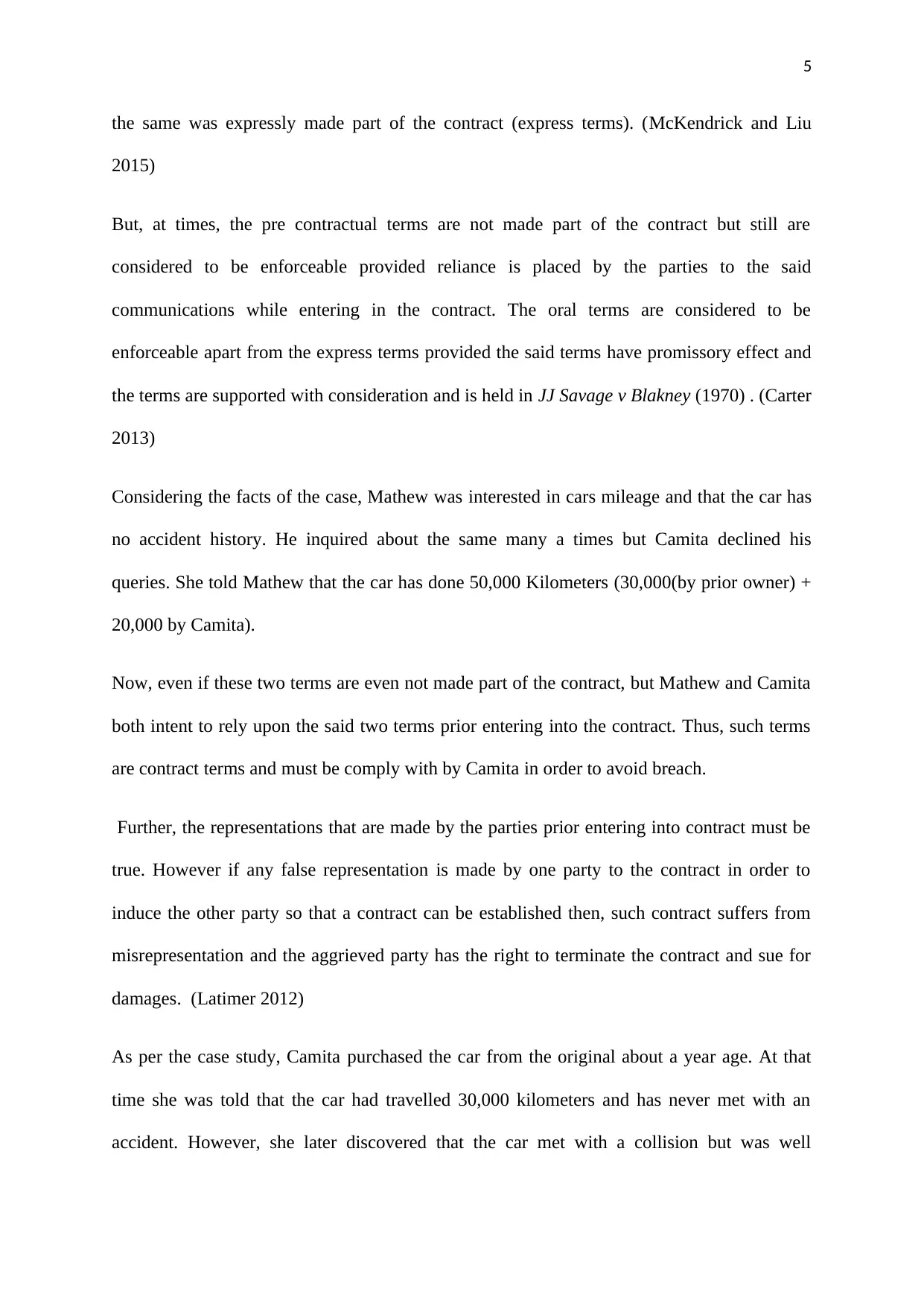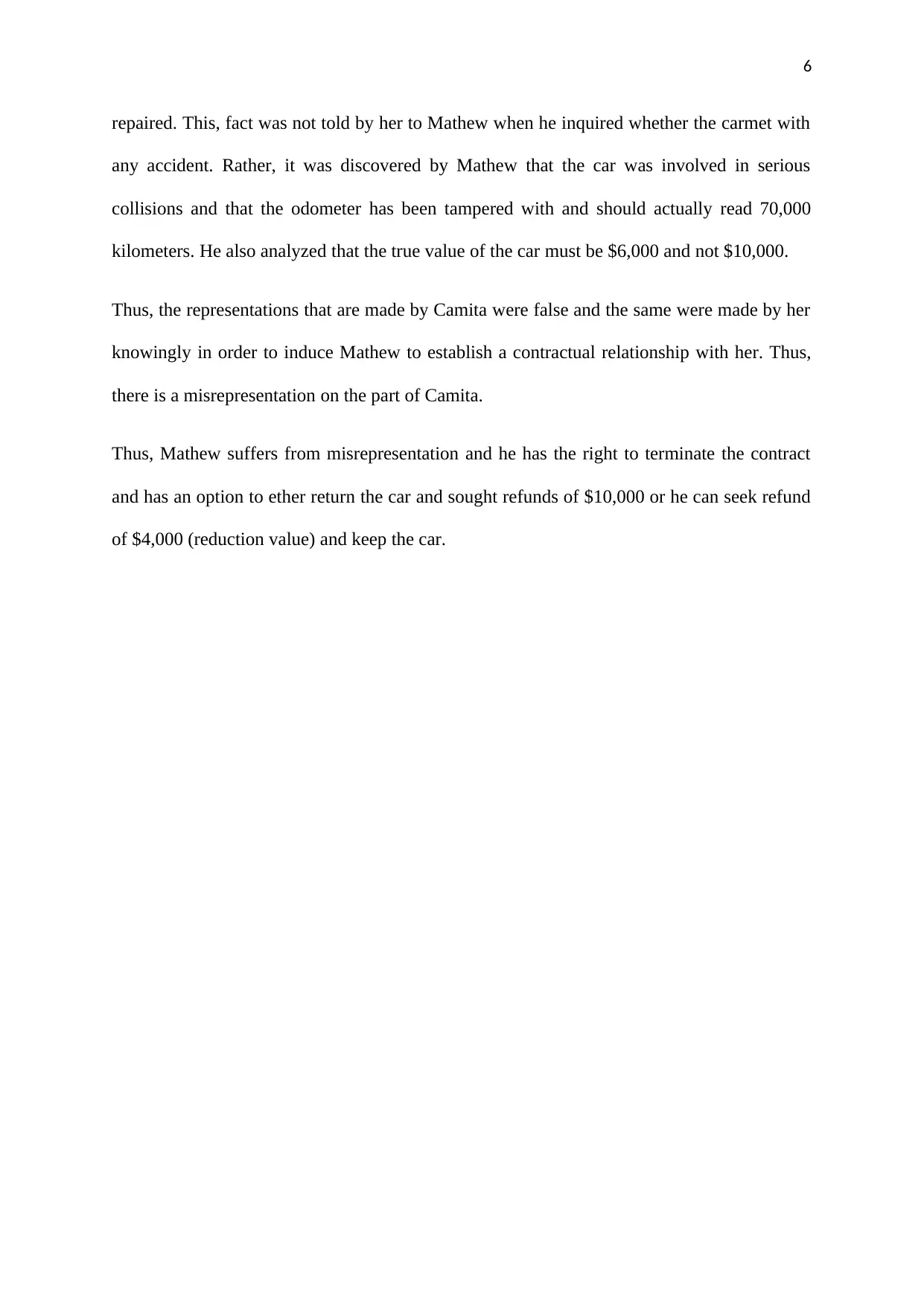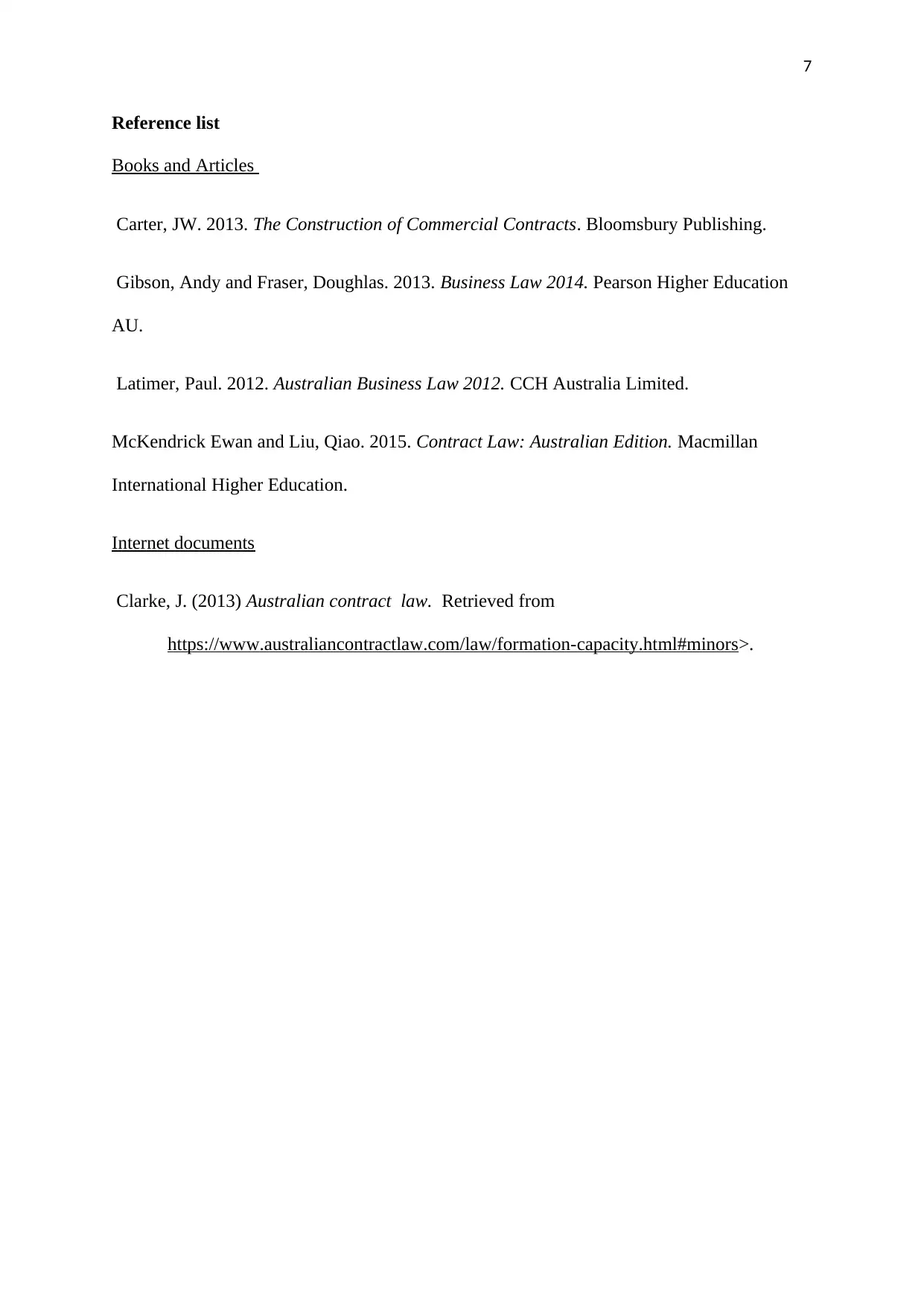Law of Contract and Principles
VerifiedAdded on 2023/01/13
|7
|1408
|27
AI Summary
This article discusses the law of contract and its principles in relation to a case study, providing advice on liability and options for the parties involved.
Contribute Materials
Your contribution can guide someone’s learning journey. Share your
documents today.

1
Title Page
Name of the student
Student ID
Title Page
Name of the student
Student ID
Secure Best Marks with AI Grader
Need help grading? Try our AI Grader for instant feedback on your assignments.

2
Contents
Solution.................................................................................................................................................4
Reference list.........................................................................................................................................8
Contents
Solution.................................................................................................................................................4
Reference list.........................................................................................................................................8

3
Solution
The law of contract is a common law and which requires the compliance of its common law
principles in order to formulate a valid legal contract amid the parties. In the present given
case study, the common law of contract and its principles are applied in order to advise
Mathew whether he is liable to asks Camita either:
To take the car back and refunds $10,000 to him or
Gives him a refund of $4,000 (reduction value) and keeping him the car.
In contract law, an offer is the first element to start a contractual relationship. As per Carlill v
Carbolic Smoke Ball Company [1892] EWCA Civ 1 when the offeror sends his
proposal/intention to an offeree with the hope that the offeree will comply with his desired
acts/omissions, then, an offer is made. As per Empirnall Holdings Pty Ltd v Machon Paull
Partners Pty Ltd (NSW) (1988) 14 NSWLR 527 when the offer so made is allowed/approved
by the offeree then it is an acceptance in law. (Gibson and Fraser 2013)
But, as per Pharmaceutical Society of Great Britain v Boots Court of Appeal [1953] 1 QB
401 when offers are invited with the help of auctions, advertisements, display of goods, then,
it is called an invitation to treat. In Partridge v Crittenden [1968] 1 WLR 1204 an
advertisement was held to be an invitation to treat. Combination of an offer and acceptance
results in the formation of an agreement. (Latimer 2012)
Considering the law to the present case analysis, it is submitted that Camita Quilla owns and
drives cars for past 16 years. She wish to sell her car @ $10,000 and thus advertises the same
in the newspaper.
As per Partridge v Crittenden [1968] an advertisement is an invitation to treat and any person
who wants to purchase the car from Camita Quilla should makes an offer to her. Camita
Solution
The law of contract is a common law and which requires the compliance of its common law
principles in order to formulate a valid legal contract amid the parties. In the present given
case study, the common law of contract and its principles are applied in order to advise
Mathew whether he is liable to asks Camita either:
To take the car back and refunds $10,000 to him or
Gives him a refund of $4,000 (reduction value) and keeping him the car.
In contract law, an offer is the first element to start a contractual relationship. As per Carlill v
Carbolic Smoke Ball Company [1892] EWCA Civ 1 when the offeror sends his
proposal/intention to an offeree with the hope that the offeree will comply with his desired
acts/omissions, then, an offer is made. As per Empirnall Holdings Pty Ltd v Machon Paull
Partners Pty Ltd (NSW) (1988) 14 NSWLR 527 when the offer so made is allowed/approved
by the offeree then it is an acceptance in law. (Gibson and Fraser 2013)
But, as per Pharmaceutical Society of Great Britain v Boots Court of Appeal [1953] 1 QB
401 when offers are invited with the help of auctions, advertisements, display of goods, then,
it is called an invitation to treat. In Partridge v Crittenden [1968] 1 WLR 1204 an
advertisement was held to be an invitation to treat. Combination of an offer and acceptance
results in the formation of an agreement. (Latimer 2012)
Considering the law to the present case analysis, it is submitted that Camita Quilla owns and
drives cars for past 16 years. She wish to sell her car @ $10,000 and thus advertises the same
in the newspaper.
As per Partridge v Crittenden [1968] an advertisement is an invitation to treat and any person
who wants to purchase the car from Camita Quilla should makes an offer to her. Camita

4
Quilla stands at the position of an offeree. Further, Mathew (17 years old) was a First year
university student inspects the car. His parents are no more and works part time to pay his
university fees. He lives in an area where there is not much public transport and it’s his first
car.
So, Mathew by relying on the advertisement makes an offer to Camita to which Camita
agrees and they finalize the deal for $10,000. Thus, an offer and an acceptance is made by
Mathew and Camita respectively resulting in the formation of an agreement.
Further, the offer and acceptance must be made by the parties who are capable to enter into
contracts. The parties are capable when they are of sound mind and has attained the age of
maturity. As per Nash v Inman [1908] 2 KB 1 the parties must have attained the age of 18
years to make a valid contract otherwise the contract is considered to be voidable (Clarke,
2013) . However, if the minor enters into the contract for legal necessity or for employment ,
then, such contracts are enforceable on behalf of the minor and is held in McLaughlin v
Darcy (1918) 18 SR (NSW) 585. (Latimer 2012)
Thus, considering the law to the facts of the case, it is submitted that Mathew was a minor
(17 years of age) but he is in need of the car as it was hid legal necessity as he was living in
the area where there is lack of public transport and thus in order to reach at his part time job,
which he is doing for his living, he is need of the transport. Thus, the purchase of car was his
legal necessity and thus Mathew is eligible to enforce the contract Camita.
One of the another important principle of the contract law is that the parties to the contract
must comply with the terms of the contract and the non compliance results in the breach of
the contract by the parties who is in violation of the contract term. Now, as per Ellul and Ellul
v Oakes (1972) 3 SASR 377 the communications that are exchanged amid the parties before
the compliance of the contract (pre contractual terms) become part of the contract provided
Quilla stands at the position of an offeree. Further, Mathew (17 years old) was a First year
university student inspects the car. His parents are no more and works part time to pay his
university fees. He lives in an area where there is not much public transport and it’s his first
car.
So, Mathew by relying on the advertisement makes an offer to Camita to which Camita
agrees and they finalize the deal for $10,000. Thus, an offer and an acceptance is made by
Mathew and Camita respectively resulting in the formation of an agreement.
Further, the offer and acceptance must be made by the parties who are capable to enter into
contracts. The parties are capable when they are of sound mind and has attained the age of
maturity. As per Nash v Inman [1908] 2 KB 1 the parties must have attained the age of 18
years to make a valid contract otherwise the contract is considered to be voidable (Clarke,
2013) . However, if the minor enters into the contract for legal necessity or for employment ,
then, such contracts are enforceable on behalf of the minor and is held in McLaughlin v
Darcy (1918) 18 SR (NSW) 585. (Latimer 2012)
Thus, considering the law to the facts of the case, it is submitted that Mathew was a minor
(17 years of age) but he is in need of the car as it was hid legal necessity as he was living in
the area where there is lack of public transport and thus in order to reach at his part time job,
which he is doing for his living, he is need of the transport. Thus, the purchase of car was his
legal necessity and thus Mathew is eligible to enforce the contract Camita.
One of the another important principle of the contract law is that the parties to the contract
must comply with the terms of the contract and the non compliance results in the breach of
the contract by the parties who is in violation of the contract term. Now, as per Ellul and Ellul
v Oakes (1972) 3 SASR 377 the communications that are exchanged amid the parties before
the compliance of the contract (pre contractual terms) become part of the contract provided
Secure Best Marks with AI Grader
Need help grading? Try our AI Grader for instant feedback on your assignments.

5
the same was expressly made part of the contract (express terms). (McKendrick and Liu
2015)
But, at times, the pre contractual terms are not made part of the contract but still are
considered to be enforceable provided reliance is placed by the parties to the said
communications while entering in the contract. The oral terms are considered to be
enforceable apart from the express terms provided the said terms have promissory effect and
the terms are supported with consideration and is held in JJ Savage v Blakney (1970) . (Carter
2013)
Considering the facts of the case, Mathew was interested in cars mileage and that the car has
no accident history. He inquired about the same many a times but Camita declined his
queries. She told Mathew that the car has done 50,000 Kilometers (30,000(by prior owner) +
20,000 by Camita).
Now, even if these two terms are even not made part of the contract, but Mathew and Camita
both intent to rely upon the said two terms prior entering into the contract. Thus, such terms
are contract terms and must be comply with by Camita in order to avoid breach.
Further, the representations that are made by the parties prior entering into contract must be
true. However if any false representation is made by one party to the contract in order to
induce the other party so that a contract can be established then, such contract suffers from
misrepresentation and the aggrieved party has the right to terminate the contract and sue for
damages. (Latimer 2012)
As per the case study, Camita purchased the car from the original about a year age. At that
time she was told that the car had travelled 30,000 kilometers and has never met with an
accident. However, she later discovered that the car met with a collision but was well
the same was expressly made part of the contract (express terms). (McKendrick and Liu
2015)
But, at times, the pre contractual terms are not made part of the contract but still are
considered to be enforceable provided reliance is placed by the parties to the said
communications while entering in the contract. The oral terms are considered to be
enforceable apart from the express terms provided the said terms have promissory effect and
the terms are supported with consideration and is held in JJ Savage v Blakney (1970) . (Carter
2013)
Considering the facts of the case, Mathew was interested in cars mileage and that the car has
no accident history. He inquired about the same many a times but Camita declined his
queries. She told Mathew that the car has done 50,000 Kilometers (30,000(by prior owner) +
20,000 by Camita).
Now, even if these two terms are even not made part of the contract, but Mathew and Camita
both intent to rely upon the said two terms prior entering into the contract. Thus, such terms
are contract terms and must be comply with by Camita in order to avoid breach.
Further, the representations that are made by the parties prior entering into contract must be
true. However if any false representation is made by one party to the contract in order to
induce the other party so that a contract can be established then, such contract suffers from
misrepresentation and the aggrieved party has the right to terminate the contract and sue for
damages. (Latimer 2012)
As per the case study, Camita purchased the car from the original about a year age. At that
time she was told that the car had travelled 30,000 kilometers and has never met with an
accident. However, she later discovered that the car met with a collision but was well

6
repaired. This, fact was not told by her to Mathew when he inquired whether the carmet with
any accident. Rather, it was discovered by Mathew that the car was involved in serious
collisions and that the odometer has been tampered with and should actually read 70,000
kilometers. He also analyzed that the true value of the car must be $6,000 and not $10,000.
Thus, the representations that are made by Camita were false and the same were made by her
knowingly in order to induce Mathew to establish a contractual relationship with her. Thus,
there is a misrepresentation on the part of Camita.
Thus, Mathew suffers from misrepresentation and he has the right to terminate the contract
and has an option to ether return the car and sought refunds of $10,000 or he can seek refund
of $4,000 (reduction value) and keep the car.
repaired. This, fact was not told by her to Mathew when he inquired whether the carmet with
any accident. Rather, it was discovered by Mathew that the car was involved in serious
collisions and that the odometer has been tampered with and should actually read 70,000
kilometers. He also analyzed that the true value of the car must be $6,000 and not $10,000.
Thus, the representations that are made by Camita were false and the same were made by her
knowingly in order to induce Mathew to establish a contractual relationship with her. Thus,
there is a misrepresentation on the part of Camita.
Thus, Mathew suffers from misrepresentation and he has the right to terminate the contract
and has an option to ether return the car and sought refunds of $10,000 or he can seek refund
of $4,000 (reduction value) and keep the car.

7
Reference list
Books and Articles
Carter, JW. 2013. The Construction of Commercial Contracts. Bloomsbury Publishing.
Gibson, Andy and Fraser, Doughlas. 2013. Business Law 2014. Pearson Higher Education
AU.
Latimer, Paul. 2012. Australian Business Law 2012. CCH Australia Limited.
McKendrick Ewan and Liu, Qiao. 2015. Contract Law: Australian Edition. Macmillan
International Higher Education.
Internet documents
Clarke, J. (2013) Australian contract law. Retrieved from
https://www.australiancontractlaw.com/law/formation-capacity.html#minors>.
Reference list
Books and Articles
Carter, JW. 2013. The Construction of Commercial Contracts. Bloomsbury Publishing.
Gibson, Andy and Fraser, Doughlas. 2013. Business Law 2014. Pearson Higher Education
AU.
Latimer, Paul. 2012. Australian Business Law 2012. CCH Australia Limited.
McKendrick Ewan and Liu, Qiao. 2015. Contract Law: Australian Edition. Macmillan
International Higher Education.
Internet documents
Clarke, J. (2013) Australian contract law. Retrieved from
https://www.australiancontractlaw.com/law/formation-capacity.html#minors>.
1 out of 7
Related Documents
Your All-in-One AI-Powered Toolkit for Academic Success.
+13062052269
info@desklib.com
Available 24*7 on WhatsApp / Email
![[object Object]](/_next/static/media/star-bottom.7253800d.svg)
Unlock your academic potential
© 2024 | Zucol Services PVT LTD | All rights reserved.





